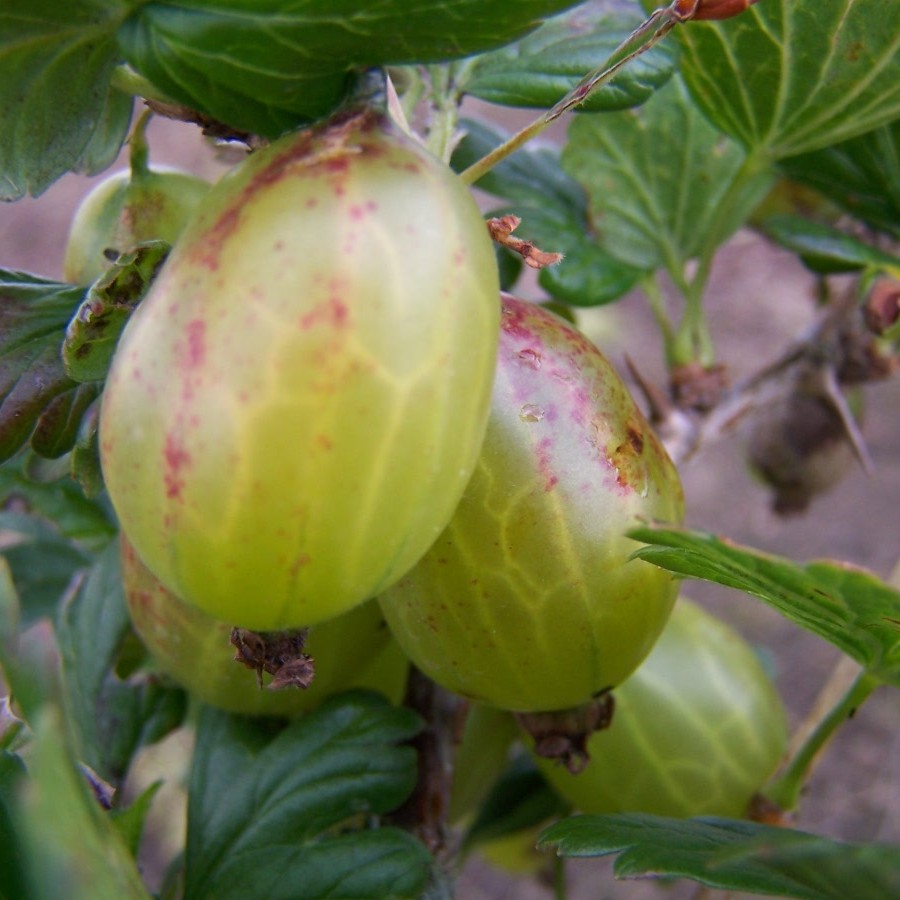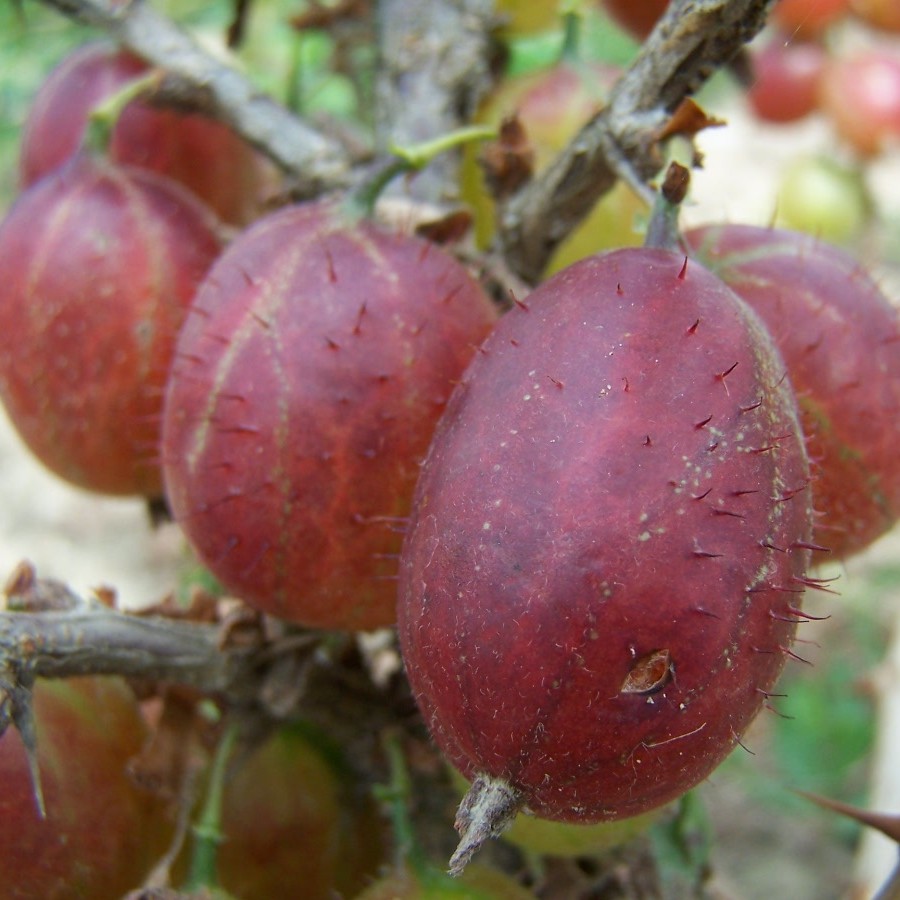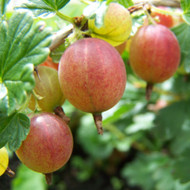Time to turn our attention to a fruit that has a somewhat ‘down at heel’ reputation – the gooseberry. It tends to be considered a basic, utilitarian fruit, good for pie fillings perhaps or for growing in a tricky site where other fruits may struggle but certainly lacking the allure of some other summer fruits. There is a persistent notion that a gooseberry is only a substitute for something better, or just fit for the kitchen. This may be rooted in snobbery - there was a long tradition in the 1800’s of competitive gooseberry growing in the Midlands and the North amongst the working class, whereas the upper classes would grow grapes and even pineapples to show off their affluence. Or it may just be that gooseberries are often picked, sold, or scrumped as underripe fruit, so they have a reputation as being sour and tart with tough skins. In fact, if you pick the right variety and show them a little love, the gooseberry can be one of the finest of soft fruit; tender, aromatic and sweet with a unique flavour that picked straight from the bush is a true delight.

History
There are two main types of gooseberry. The one we are familiar with is the European gooseberry Ribes uva-crispa. Native to Europe, it was introduced in Britain in the 13th century (Edward I had plants shipped over from France), and soon gained widespread popularity. The 1800’s were the golden age of gooseberry growing in the UK, where competitive shows were organised up and down the land as cottage gardeners vied to produce the largest fruit. The Gooseberry Grower’s Register (a national periodical devoted to the art of gooseberry growing, first published in 1786) lists over 171 gooseberry shows taking place in 1845. Indeed the oldest surviving gooseberry show in the country, first held in 1800, still takes place on the first Tuesday in August each year at Egton Bridge, on the edge of the North York Moors. It’s in this period that many of the heirloom varieties were introduced, as amateur growers raised their own seedlings to bolster their chances of success – names such as Crown Bob, Lancashire Lad and Langley Gage, many of which you can still find offered for sale today.
The American gooseberry, Ribes hirtellum, is native to Canada and the northern United States and is not grown in the UK. However, it is of interest as although the fruit are much smaller and not as sweet as the European gooseberry, it has ace up its sleeve – its extremely disease-resistant, so has been used in modern breeding programmes to try and combine the best of both species to produce large sweet fruit on a healthy and robust plant.

Cultivation
Gooseberries are very unfussy about soil and site – extremely hardy, they will grow just about anywhere. It may be because of this that they can get neglected or just used to fill problem area, but with a little care and attention you can get much better quality and more flavoursome fruit.
Gooseberries are amongst the longest living plants of any soft fruit – they can crop well for thirty years or more – so spend a little time in choosing the best position and preparing the soil. Gooseberries will grow well in sun or part shade, but their one crucial requirement is a soil which doesn’t dry out. Incorporate as much organic matter as possible into the soil before planting, and if you have existing plants then mulch, mulch, and mulch again. Applying a thick layer of homemade compost, composted bark, leaf mould or straw in early Spring when the soil is damp will help retain moisture, not only allowing the fruit to swell and ripen, but crucially will help ward off gooseberry mildew. Mildew is probably the number one issue with growing gooseberries, and unfortunately many of the older, tastier varieties are quite prone to it. An attack in early summer can devastate that year’s crop, but if you make sure the plant doesn’t suffer from any stress due to drought, your chances of success increase dramatically. One mulch it is best to avoid, however, would be well-rotted manure – its high in nitrogen and excess nitrogen promotes lush new growth which is particularly prone to mildew.
Allow plenty of space and don’t be tempted to crowd too many together - about 1.2m per plant is the minimum. Good air circulation also improves the quality and flavour of the berries, and lowers the risk of attack from pest and disease.
Pruning is generally carried out every winter, and should not be neglected – an ignored plant can quickly become an impenetrable tangle of thorny stems. The goal here is to create a ‘wine glass’ shape, with 5 or 6 stems radiating out in an open bowl. These main shoots should be reduced by about a quarter of that year’s growth every December. From these main stems, the plant will throw out many lateral shoots, and this is where the majority of the fruit will be born the following year. Keep these laterals fairly short, and remove any that grow into the centre of the plant or cross over with their neighbour. The harder you prune these laterals, the larger the fruit next year, worth knowing if the competitive side of you has given you a yearning for top spot in the village show! Even without such lofty ambitions, keeping the plants pruned hard improves air circulation and takes away stem tips which harbour mildew spores over the winter months.
Varieties
Until breeding programmes manage to produce the holy grail of a gooseberry variety which is both delicious and disease resistant, you face a distinct compromise when choosing a variety to grow – go for one of the traditional ones for the absolute very best flavour, a true delight for the palate, or a more disease-resistant and easier to grow new variety, but where the flavour doesn’t quite hit the same heady heights.
Best of the Traditional:
Careless – introduced before 1860, this is a classic midseason pale green variety. Heavy to crop and a good flavour, producing large smooth skinned fruit. Can be a little sprawling in growth, so prune to bud facing upwards to control the growth.
Leveller – in terms of fruit quality, this is probably the best all-rounder. Very large, pale yellow green fruit with a superb flavour. On the down side, is one of the more prone to gooseberry mildew.
Whitesmith – large, white fruit with a pale yellow blush, when fully ripe they are first rate dessert fruit. Introduced in 1824.
Langley Gage – the sweetest of all, a fully ripe silvery white Langley Gage gooseberry is an absolute treat, bursting with sugar. As a bonus, this is quite resistant to mildew attack.
Lancashire Lad – a classic red mid-season gooseberry, introduced in 1824 and still going strong.
(There are many other historic varieties you can still find for sale, more so than for any other type of soft fruit, so narrowing it down to this shortlist was hard – honourable mentions must also go to High Sheriff, Ironmonger, Hero of the Nile and Jubilee)
Disease resistance:
Hinnonmaki series: One of a range of hybrids bred in Finland, aiming to combine the flavour of the European gooseberry with the robustness of the American species. 3 varieties are commonly available – Red, Green and Yellow – and each is definitely worth considering if disease-resistance is top of your list of priorities. The Red form is probably the sweetest fruit, the Green is the heaviest cropper and an excellent culinary fruit whilst the Yellow-berried form falls somewhere between the two.
Martlet – another new mildew-resistant hybrid, producing heavy crops of dark red fruit. Possibly the sweetest fruit of any of the newer varieties.
On a final note, you may be wondering why I haven’t mentioned one particular thorny issue – the thorns! European gooseberries can be vicious, covered in barbs which can rival any rose, so plant breeders have produced a few varieties which are thorn free (or at least claim to be). However my experience is that many of these are quite weak in growth, and prone to die-back in the winter – certainly up here in the North of the UK. So, until they produce a thornless variety which is anywhere near as good as the traditional types, I’ll happily run the gauntlet of thorns and grazed skin to get to the most flavoursome fruit.

